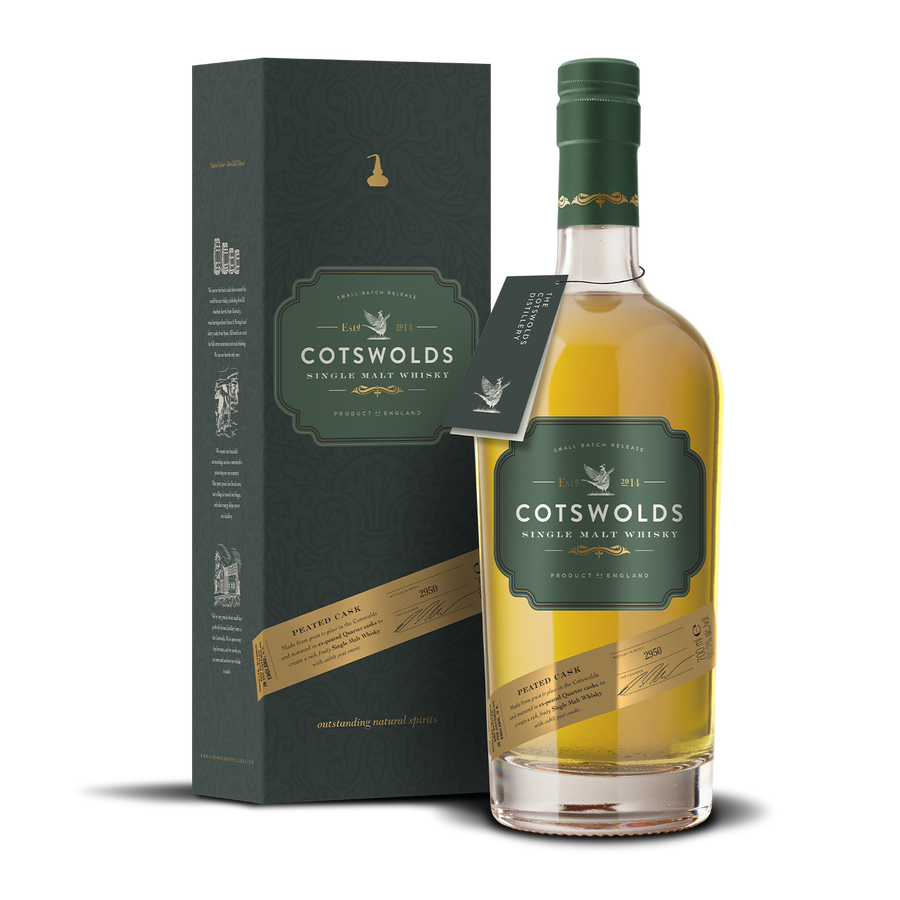Discover the Delicate Flavours of Light and Citrussy Single Malt Whisky
Citrus flavours are almost universally loved in the food and beverage industry. They’re incredible at balancing richness and brightening your palate. However, the citrus flavours in single malt don’t come from adding fruit. Zest and acidic flavours can be found elsewhere in nature and make their way into the whisky during fermentation, distillation and maturation.
Discover some of the most delicate and balanced single malt whisky blends from the Cotswolds Distillery and learn how to find the most satisfying dram every time.
- Top picks for light and citrussy single malt whiskies
- Crafting the perfect citrus profile in single malt whisky
- Frequently Asked Questions
Enjoy a balanced and delicate single malt from the Cotswolds Distillery
What makes a whisky citrussy – fermentation to maturation
Top Picks for a Light and Citrussy Dram

1. Cotswolds Signature Single Malt Whisky
Why the Signature is a Favourite
“It has all of those big, accessible, fruity flavours. It can defined in different ways - marmalade on toast, apples & pears, honey and lemon. It’s just a really great whisky”.
- Rob Patchett, Whisky Ambassador at Cotswolds Distillery

Cotswolds Distillery’s Signature Single Malt to impress decades on from the first batch. It blends whisky aged in Bourbon and STR barrels for a flavourful but approachable profile, packed with honey, citrus, orchard fruit, tropical fruit, nuts and a touch of cinnamon. This whisky is a bestseller for good reason.
Barrels: STR red wine, Bourbon
Flavours: Honey, citrus, tropical fruit, orchard fruit, baking spices, toasted almonds
ABV: 46%
2. Peated Cask Single Malt Whisky

Love it or hate it, peat is a key flavour in the world of single malt, especially single malt Scotch whisky. Regions such as Islay or Speyside are known for their peatier expressions but The Cotswolds Distillery offers a delicately smoky option in the Peated Cask Single Malt whisky. It uses quarter casks recycled from peated whisky production, these impart second-hand peat for a lighter body. You’ll get a bright and balanced palate without overpowering smoke. Our distillers describe it as ‘smoky vanilla ice cream’. Explore peated cask whisky
3. Bourbon Cask Single Malt Whisky

Taste the best of both. Bourbon barrels enhance the decadence of a single malt whisky; often responsible for citrus flavours, honey, apple, pear, vanilla and butterscotch. This cask expression is no different. Taste vanilla, honey and lemons. Explore the decadence of Bourbon Cask Single Malt.
Barrels: Bourbon only
Flavours: Vanilla, butterscotch, cinnamon, honey, lemon, pear, apple, coconut.
AVB: 59.1%
4. Harvest Series Amber Meadow Single Malt Whisky

Our final recommendation blends whisky from Moscatel barrels and Bourbon barrels for a unique, bright and fruity expression with subtle hints of honey, vanilla and peat.
Barrels: Bourbon only
Flavours: Honey, pears, vanilla, peat, orange peel and apricot.
ABV: 59.1%
Crafting the Perfect Citrussy Single Malt Whisky

Influence of Cask Selection
While the type of casks used can enhance citrussy profiles such as Bourbon barrels (American oak), citrus is more often attributed to the base spirit. Barrel section involves choosing seasonings that don’t overpower the whisky’s delicate expression.
Bourbon barrels are typically made from American oak which contains more aromatic compounds in the wood lignin than other types. Once charred, it releases a variety of flavours including vanilla and caramel coconut, to peach and citrus.
Whisky age is a key factor too, younger whiskies rely on the flavour of the base spirit, whereas, longer maturation periods will increase the amount of flavour taken on from the oak, in addition to deepening the colour of the liquid.
The Role of Distillation and Fermentation Techniques
Arguably more important are the fermentation and distillation techniques. These build citrus profiles and ensure they reach the final product. Explore the influence of each stage below.
Fermentation
When yeast is added to a carbohydrate-rich environment such as wort, it starts to ferment the sugars into ethanol (alcohol) and produces other compounds in the process. Esters and phenols are common by-products of fermentation and they’re also key for adding fruity aromas such as banana, pineapple, lemon, orange, peach and floral expressions . Here are some of the key esters and phenols that are responsible for fruity and citrussy notes:
- Ethyl acetate – Fruity, pear-like, sometimes lemony
- Isoamyl acetate – Banana, sometimes hints of citrus
- Linalool – Floral, orange blossom, bergamot
- Geraniol – Citrusy, lemony, floral
- β-Citronellol – Lemon, lime-like
How we do Things at The Cotswolds Distillery
“We leave [the worts to ferment] for an extra 2 days...What that does is it creates loads of fatty acids and esters and really oily compounds that create big flavours that can be transferred through distillation... It just smells like banana bread and pineapple it’s amazing!”
- Rob Patchett, Whisky Ambassador at Cotswolds Distillery
Distillation
We aim to keep as many of those fruity flavours as possible through distillation, our unique cut points allow the majority of those big flavour compounds through, while leaving the heavier compounds behind. Multiple batch distillations in copper pot stills also help us achieve a flavourful but clean heart cut ready for maturation.
How we do Things at The Cotswolds Distillery
“We’re not creating a spirit where the flavour needs to be created by the wood but creating a spirit that is really fruity grappa/eau de vie-style that can be accentuated by the barrels. We’re already pre-loading flavour in production so the barrels can just add more flavour. It’s about assessing each stage of production - does it make more flavour? Yes. Let’s do that.”
- Rob Patchett, Whisky Ambassador at Cotswolds Distillery
Frequently Asked Questions
What Makes a Whisky Citrussy?
Citrus flavours can come from every stage of production. Fruity and citrussy flavours are first introduced during fermentation and these are preserved by distillation and then accentuated during maturation. American oak barrels can create bright, citrussy notes.
How Does Cask Type Influence Whisky Flavour?
Every cask used to age whisky (or any other liquid) is unique and becomes more so after it has exchanged flavour with its contents. A master distiller chooses the right barrel based on desired characteristics. They may also blend whisky from different barrels to achieve a balanced profile. Explore our guide to the types of single malt.
Can Peated Whisky Be Light and Citrussy?
While notoriously overpowering, there are many lightly peated whisky options that highlight citrus notes and offer a lighter body. Peated cask single malt is also a good alternative if you don’t want a heavily smoked dram.
Which regions in the United Kingdom Produce Light an Citrussy Whisky?
The Isle of Arran is known for its bright and citrussy expressions although it all comes down to production. The classic Arran citrus notes and the warming maritime spice of Lochranza are perfect for delicate Scotch whisky lovers.
Your guide to floral and herbaceous whisky

